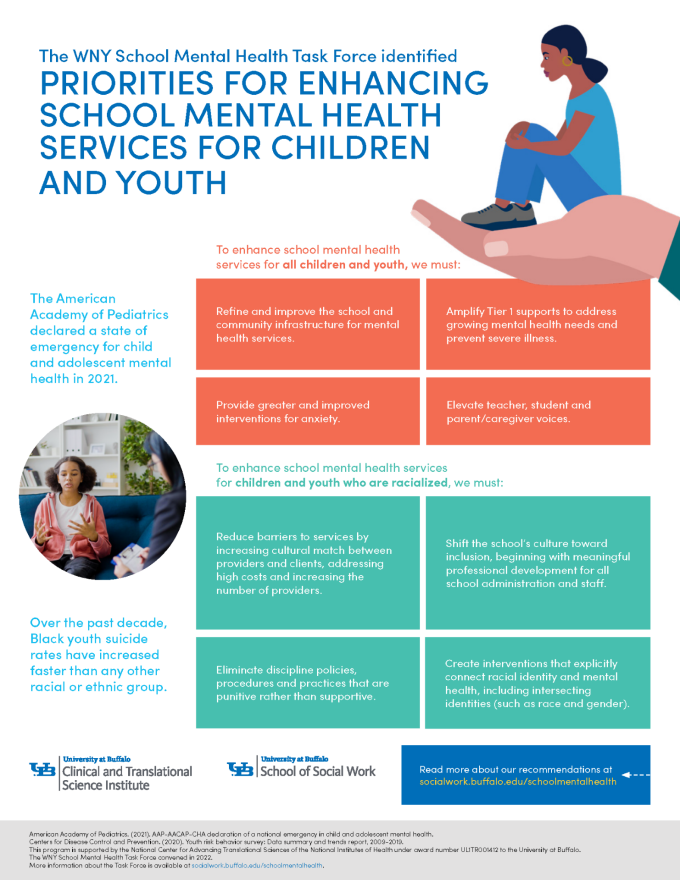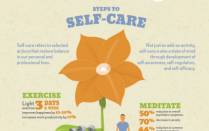Enhancing School Mental Health Services for Children and Youth
In response to a national mental health crisis, the WNY School Mental Health Task Force outlines policy and practice priorities to strengthen mental health services in schools.

Child and adolescent mental health is a national emergency (American Academy of Pediatrics, 2021). The COVID-19 pandemic accelerated already increasing rates of depression, anxiety, loneliness and suicidal ideation (Naff et al., 2022). Suicide is now the second leading cause of death for youth aged 10-18. The youth mental health crisis is not limited to significant mental illness alone. For example, in 2021, 4 out of 10 high school students reported “persistent feelings of sadness or hopelessness” (U.S. Department of Health and Human Services, 2021).
The effects of this crisis vary across racial subgroups of children and youth. White and Native youth have the highest rates of suicide among all youth, yet Black youth suicide rates increased faster than any other racial group in the past decade (CDC, 2020, Ramchand et al., 2021). Additionally, Asian American youths’ mental health needs are largely unmet and they have lower engagement in mental health services than their white peers (Li et al., 2010; Spencer et al., 2010).
The Western New York (WNY) School Mental Health Task Force convened in 2022 to identify priorities for enhancing school mental health services for children and youth.
To enhance school mental health services for all children and youth, we must:
- Clarify roles and responsibilities of school mental health professionals.
- Increase youths’ and families’ access to providers.
- Strengthen mental health-education collaboration.
- Identify clear target outcomes and interventions across a multi-tiered system of support that are sustainable over time.
- Support teachers in implementing classroom-based interventions.
- Use whole-school approaches to bolster healthy development for all youth.
- Interventions should recognize academic-based and non-academic-based experiences of anxiety.
- Emphasize individual, small group and whole-school approaches.
- Support all stakeholders in implementing novel approaches.
- Include and center the voices of teachers, students and parents/caregivers in school mental health initiatives.
To enhance school mental health services for racialized children and youth, we must:
- Increase the number and capacity of community providers to meet diverse needs of racialized youth and families.
- Address high costs of service.
- Provide culturally relevant services.
- Discipline policies, procedures and practices routinely punish racialized youth and limit schools’ ability to identify and address mental health needs.
- Consider alternative approaches to discipline, such as restorative practices, peer support and peer-to-peer mentoring, or logical consequences.
- Use existing evidence and theory on racialized youth, racial identity development and racial trauma to inform prevention and intervention for racialized youth.
- Understand and apply intersectional concerns and approaches to address differential experiences of youth and families.
- Infuse diversity, equity and inclusion (DEI) priorities throughout all school climate initiatives.
- Include many stakeholders in building an inclusive school climate, including administration, staff, students, families and community partners.
Chair
- Annahita Ball, PhD, associate professor, University at Buffalo School of Social Work
Co-Chair
- JoAnn Balazs, Esq., assistant superintendent, Sweet Home Central School District
Members
- Megan Bailey, MSW ’21, PhD candidate, University at Buffalo School of Social Work,
- Katie Barillari, director of special programs, Sweet Home Central School District
- Rosa D’Abate, PhD, coordinator of student services, Williamsville Central Schools
- Anne Nowak, program director, Family Support Center, Sweet Home Central School District
- Maria Oddo, director of special education and pupil personnel services, Amherst Central School District
- Anthony Scanzuso, assistant superintendent, exceptional education and student services, Williamsville Central Schools
- Candra Skrzypek, MSW ’17, LMSW, PhD candidate, University at Buffalo School of Social Work
- Rolanda Ward, PhD, associate professor of social work, Niagara University
- Evan Vahratian, coordinator, Family Support Center, Clarence Central School District
Special Thanks
American Academy of Pediatrics. (2021). AAP-AACAP-CHA declaration of a national emergency in child and adolescent mental health. https://www.aap.org/en/advocacy/child-and-adolescent-healthy-mental-development/aap-aacap-cha-declaration-of-a-national-emergency-in-child-and-adolescent-mental-health/
Centers for Disease Control and Prevention. (2020). Youth risk behavior survey: Data summary and trends report, 2009-2019. https://www.cdc.gov/yrbs/dstr/pdf/YRBSDataSummaryTrendsReport2019-508.pdf
Li, H., & Seidman, L. (2010). Engaging Asian American youth and their families in quality mental health services. Asian Journal of Psychiatry, 3(4), 169–172. https://doi.org/10.1016/j.ajp.2010.08.008
Naff, D., Williams, S., Furman-Darby, J., & Yeung, M. (2022). The Mental Health Impacts of COVID-19 on PK–12 Students: A Systematic Review of Emerging Literature. AERA Open, 8. https://doi.org/10.1177/23328584221084722
Ramchand, R., Gordon, J. A., & Pearson, J. L. (2021). Trends in suicide rates by race and ethnicity in the United States. JAMA network open, 4(5), e2111563-e2111563.
Spencer, M., Chen, J., Gee, G., Fabian, C., Takeuchi, D. (2010). "Discrimination and Mental Health-Related Service Use in a National Study of Asian Americans." American Journal of Public Health, 100(12), 2410-2417.
U.S. Department of Health and Human Services. (2022). 2022 National Healthcare Quality and Disparities Report. Rockville, MD: Agency for Healthcare Research and Quality. AHRQ Pub. No. 22(23)-0030.
How to cite
Ball, A. (2023). Enhancing School Mental Health Services for Children and Youth. Western New York School Mental Health Task Force. https://socialwork.buffalo.edu/schoolmentalhealth
Published May 17, 2023

